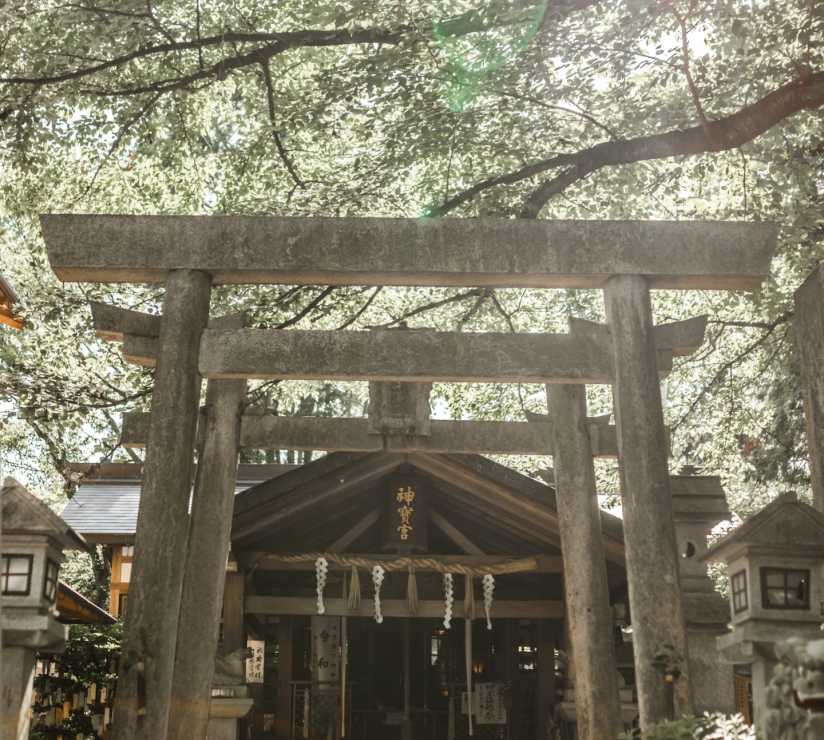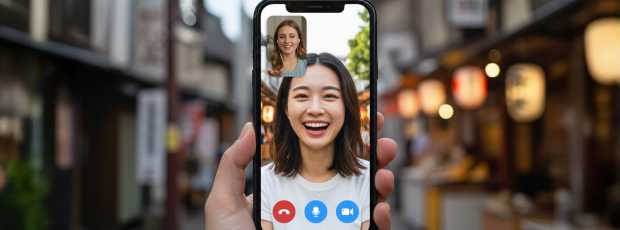Alex was an amazing guide! Showed us around all the sites, including those off the normal touristy routes. The tour was excellent!Heather, Kyoto, 2025
Table Of Contents
- Where Kyoto Blooms in Spring
- When Kyoto's Cherry Blossoms Begin to Bloom
- Essential Cherry Blossom Viewing Spots in Central Kyoto
- Exploring Temple Gardens in Full Bloom
- Northern Kyoto's Spring Secrets
- Western Kyoto and Arashiyama's Natural Beauty
- Spring Festivals and Cultural Traditions in Kyoto
- Transportation and Timing Strategies
- Beyond Famous Spots: Local Discoveries
- Rivers, Gardens, and Seasonal Rhythms
- Photography Tips for Capturing Kyoto in Spring
- Food, Culture, and Seasonal Celebrations
- Planning Your Kyoto Trip in Spring
- Seasonal Transitions and Extended Spring
- One Gentle Petal at a Time
Where Kyoto Blooms in Spring
Spring’s Quiet Arrival
Spring arrives in Kyoto like a whispered secret. First comes the gentle warmth that touches your cheek during morning walks. Then comes the soft pink promise that begins to emerge from bare cherry trees throughout the city. I’ve watched this ancient imperial capital transform in springtime more times than I can count, and still, I find myself drawn again and again to the same quiet corners where cherry blossoms unfurl with the patience of centuries.
A City in Full Bloom
The cherry blossom season in Kyoto isn't just about the famous spots everyone knows. It's about discovering the rhythm of bloom that moves through our temples, gardens, and hidden pathways like a slow dance. From late March through April, when the sakura reach full bloom, this city becomes a living poem written in pink and white petals.

A local in traditional dress admires full-bloom cherry trees along a peaceful garden path in Kyoto.
Why I Return to Kyoto Every Spring
Many travelers visit Tokyo during sakura season, drawn to the capital's famous cherry blossom displays and bustling energy. Yet after experiencing Tokyo's popular spots, some find themselves yearning for a quieter communion with spring's beauty, the kind that visiting Kyoto offers so generously. Unlike Tokyo's crowded viewing areas, Kyoto's sacred spaces like Fushimi Inari Shrine provide opportunities for more intimate encounters with both cherry blossoms and spiritual tradition.
From Gion Shijo Station, you can easily reach these contemplative destinations where sakura viewing becomes less about checking off famous locations and more about developing a genuine connection with the season's gentle rhythms.
For those planning a seasonal trip, exploring Kyoto experiences across the year helps build a deeper connection with the city. While spring draws many for its cherry blossoms, Kyoto has distinct rhythms in every season. Each one offers something different to discover.
When Kyoto's Cherry Blossoms Begin to Bloom
When Cherry Blossoms Begin Their Journey
The cherry blossom season typically begins in late March, though nature keeps her own schedule. I've learned to read the early signs. There are the swelling buds on cherry trees along the Kamogawa River, the way sunlight lingers a few minutes longer each evening, and the subtle shift in the air that Japanese people call the "scent of spring."
Early April brings the most spectacular displays, when cherry blossoms reach their peak throughout the city. This is when temples like Nanzen Ji Temple and gardens across northern and western Kyoto transform into ethereal landscapes of bloom. The full bloom period usually lasts about a week, though gentle varieties like the weeping cherry tree may linger longer.

Cherry blossoms begin to bloom as soft dawn light touches temple grounds in Kyoto.
How Kyoto’s Cherry Blossom Season Gently Ends
Late April often brings the season's gentle conclusion, when petals begin their dance to the ground. But this too has its beauty, the way fallen blossoms carpet pathways and float along streams, reminding us that impermanence itself is part of nature's design.
Understanding when different areas bloom is helpful. Most spots follow a two-week window around early to mid-April, but some, like Ninna-ji Temple with its late-blooming Omuro cherry trees, can extend the season into late April or even early May. Planning around these variations offers a chance to enjoy sakura just a little longer.
Experience Kyoto and Beyond, Your Way
Explore Kyoto and nearby gems with a local host. These are flexible, personal experiences. Not your typical group tour.
Essential Cherry Blossom Viewing Spots in Central Kyoto
Maruyama Park: The Heart of Hanami Culture
Maruyama Park remains Kyoto's most beloved hanami destination, where families and friends gather beneath blooming cherry trees for traditional flower viewing celebrations. The park's famous weeping cherry tree, illuminated at night during cherry blossom season, creates an almost mystical atmosphere that draws both Japanese people and visitors from around the world. It's also where I go every spring, that glowing weeping cherry is my favorite view in the whole city.
The beauty of Maruyama Park isn't just in the blossoms. It's in witnessing hanami as it's meant to be. Lively. Joyful. Shared. Early mornings offer quiet moments before the crowds arrive. Evenings bring out a more festive mood, with hanami parties that show just how deeply this tradition is woven into Japanese spring.

Families enjoy cherry blossom picnics under glowing trees during hanami season in Maruyama Park at dusk.
Kyoto Imperial Palace and Kyoto Gyoen National Garden
The grounds surrounding the imperial palace offer some of the city's most refined cherry blossom viewing. Kyoto Gyoen National Garden spreads across 65 hectares. There's ample space to find quiet corners even during peak bloom.
The garden's cherry trees include early-blooming varieties that flower in late March. This extends the season for those who arrive early.
Walking these imperial grounds feels like stepping into the Heian period, when court nobles composed poetry beneath flowering branches. The contrast between ancient palace walls and delicate cherry blossoms creates scenes that feel timeless. Especially in the soft light of early morning or late afternoon.
Hidden Gems Near Kyoto Station
Even near the bustling transportation hub of Kyoto Station, spring reveals its quiet magic. Temple gardens in this area often overflow with cherry blossoms, yet stay surprisingly peaceful. These hidden spots offer authentic flower-viewing experiences without the overwhelming crowds.

Cherry blossoms and morning mist frame a traditional temple gate near Kyoto Station.
Exploring Temple Gardens in Full Bloom
Sacred Spaces: When Temples Transform
Kyoto's temples take on ethereal beauty during cherry blossom season. Each temple garden seems designed to frame the delicate flowers perfectly, creating compositions that shift with the light throughout the day. The interplay between architectural elements and natural beauty reaches its peak when cherry trees reach full bloom.
Kiyomizu Dera Temple: Elevated Beauty
Kiyomizu Dera Temple offers elevated views of cherry blossoms cascading down the hillside, creating layered landscapes of bloom that extend toward the city below. Spring transforms this wooden temple into a platform for observing not just cherry blossoms, but the entire rhythm of the season unfolding across Kyoto's eastern mountains.
The temple's famous wooden stage provides perspective on how spring moves through the landscape, from the earliest plum blossoms in temple gardens to the wave of cherry bloom that follows. Visiting during different times of day reveals how light changes the character of both blossoms and the city beyond.
Kodai Ji Temple: Intimate Garden Moments
Kodai Ji Temple's more intimate gardens create perfect spaces for quiet contemplation during cherry blossom season. The temple's carefully designed landscapes frame cherry trees against traditional architecture, creating scenes that feel like living paintings. Night illuminations during bloom season add another dimension to the beauty.
The temple's connection to the tea ceremony tradition becomes especially meaningful in spring, when the changing seasons remind us of the importance of appreciating each moment’s unique character.

A monk sweeps cherry blossom petals in a peaceful temple courtyard lit by soft morning light.
Cherry Blossom Gardens at Kyoto’s Ji Temples
Throughout Kyoto, ji temples (those ending in "ji") offer diverse experiences of cherry blossom viewing. Each temple's garden reflects different aspects of Japanese aesthetic principles, from the dramatic compositions at Daigo-ji to the subtle restraint of smaller neighborhood temples.
These sacred spaces provide context for understanding how cherry blossoms fit into Japanese spiritual and cultural traditions. The flowers' brief bloom becomes a meditation on impermanence and beauty, themes central to Buddhist thought.
Walking this path feels like a moving meditation, especially in the early morning when few others are about.
Northern Kyoto's Spring Secrets
Ginkaku Ji: The Silver Pavilion's Spring Garden
Northern Kyoto's Ginkaku Ji, or Silver Pavilion, offers refined spring experiences away from the most crowded destinations. The temple's meticulously maintained gardens provide intimate settings for observing cherry blossoms alongside other spring flowers. The contrast between different blooming seasons creates layered beauty throughout March and April.
The temple's elevated position provides views across the city, allowing visitors to see how spring progresses through different neighborhoods and elevations. This perspective helps us understand the broader rhythm of the cherry blossom season across Kyoto.
The Philosopher's Path: A Walking Meditation
The Philosopher's Path creates a gentle walking route through northern Kyoto during cherry blossom season. This stone pathway beside a quiet canal becomes lined with cherry trees in full bloom, creating a tunnel of flowers that filters sunlight into soft, pink-tinted patterns.
Walking this path feels like a moving meditation, especially in the early morning when few others are about. The sound of water flowing beneath falling petals adds another sensory layer to the experience. The path connects several temples and makes it possible to visit multiple gardens in bloom during a single contemplative walk.
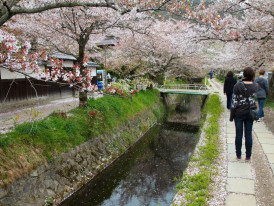
Cherry blossom petals float on canal water with dappled sunlight along Kyoto’s Philosopher's Path in spring.
Hidden Northern Gardens
Beyond famous destinations, northern Kyoto holds numerous smaller temples and gardens where cherry blossoms bloom in peaceful settings. These locations rarely become crowded, offering more personal connections with the season's beauty.
Neighborhoods here often have cherry trees lining their streets, creating everyday beauty that residents enjoy throughout the blooming season. These simple pleasures remind us that spring's gifts extend far beyond tourist destinations.
Western Kyoto and Arashiyama's Natural Beauty
Sacred Mountains and Cherry Groves
Western Kyoto's temples nestle among hills where cherry blossoms seem to emerge naturally from the landscape. The relationship between cultivated gardens and wild mountain slopes creates particularly beautiful compositions during spring, when everything feels balanced and in motion. Cherry trees planted generations ago have grown to impressive sizes, their branches extending over temple courtyards and pathways.
Ninna Ji Temple: Late Season Beauty
Ninna Ji Temple becomes especially precious in early to mid‑April, when its famous Omuro cherry variety reaches full bloom. This typically happens after most other cherry blossoms have faded. These late-blooming cherry trees extend the season for those fortunate enough to witness their brief but spectacular display.
The temple's pagoda rising among cherry blossoms creates iconic views that capture the essence of Japanese spring. Night illuminations during the blooming period add dramatic beauty to the already spectacular natural display.
Visit Arashiyama: Bamboo and Blossoms
When you visit Arashiyama during spring, the famous bamboo grove shares attention with numerous cherry trees throughout the district. The combination of bamboo's year-round green with spring's delicate pink creates striking natural contrasts. The area's temples each contribute their own cherry blossom displays to the seasonal symphony.

Cherry blossoms and bamboo create a natural tunnel effect in Kyoto’s Arashiyama district during spring.
Reaching Arashiyama via Saga Arashiyama Station places you immediately in the heart of this natural wonderland. The train journey itself becomes part of the experience as the train passes through landscapes dotted with blooming trees.
See Kyoto the way locals do
Explore Kyoto with a local host who plans a flexible, personal day based on your interests and pace.
Spring Festivals and Cultural Traditions in Kyoto
Cherry Blossom Festival Traditions
Kyoto's cherry blossom festival celebrations extend far beyond simple flower viewing. Throughout the city, temples and shrines host special events during the bloom season, from traditional performances to tea ceremony demonstrations. These festivals connect visitors with centuries-old traditions of celebrating spring's arrival.
The festival atmosphere during peak bloom creates opportunities to experience Japanese culture in authentic settings. Local communities organize hanami gatherings that welcome respectful participation, offering insights into how Japanese people traditionally celebrate the season.
Aoi Matsuri: Spring's Grand Celebration
The Aoi Matsuri festival in May extends Kyoto's spring celebration season and connects cherry blossom time with summer's approaching warmth. This ancient festival, dating to the Heian period, demonstrates how deeply seasonal celebrations are woven into Kyoto's cultural fabric.
Watching the Aoi Matsuri procession provides context for understanding how imperial capital traditions continue to shape modern Kyoto. The festival's connection to seasonal change reflects the same appreciation for natural beauty that makes cherry blossom viewing so meaningful.
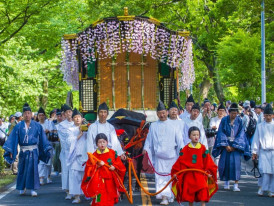
People in Heian period costumes walk in the Aoi Matsuri festival procession surrounded by Kyoto’s springtime scenery.
Tea Ceremony in Spring Gardens
Spring offers ideal conditions for outdoor tea ceremony experiences in temple gardens. The presence of cherry blossoms adds seasonal awareness to this traditional practice, connecting participants with the natural rhythms that influence Japanese aesthetics.
Many temples offer special tea ceremony sessions during cherry blossom season, so visitors can experience this cultural practice while surrounded by spring's beauty. These experiences provide a deeper understanding of how Japanese culture integrates natural observation with spiritual practice.
Transportation and Timing Strategies
Navigating Spring Kyoto
Getting around Kyoto during cherry blossom season requires some planning. Popular destinations can become extremely crowded during peak bloom times. Understanding the city's transportation network helps maximize your experience and reduce the time spent in crowds.
The Karasuma Subway Line provides efficient access to central destinations. The Keihan Main Line connects eastern temple districts. For western destinations, the Hankyu Line offers reliable service to Arashiyama and the surrounding areas.
Station-Specific Access Points
From Gion Shijo Station, you can easily reach the Philosopher's Path and the eastern temple districts. Kawaramachi Station provides access to central areas and the path to Maruyama Park. Keage Station serves as the entry point for eastern mountain temples like Nanzen Ji Temple.
Knowing which stations connect to which destinations helps you plan more efficient routes. It also helps you anticipate walking distances and elevation changes. Many of the best cherry blossom viewing spots require a bit of walking from the nearest station.
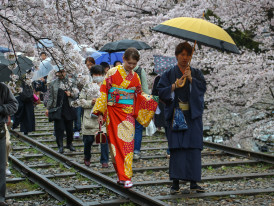
Early morning commuters at Keage Station with cherry blossoms blooming along the edge of the platform.
Timing Your Visits
Arriving early at popular destinations rewards you with peaceful experiences before crowds gather. Most temples open at dawn, allowing for serene morning visits when cherry blossoms appear most ethereal in soft light.
In the last week of bloom season, late afternoon visits offer a different kind of beauty. Petals begin their gentle descent, and the fading light brings a quiet, reflective mood. Evening visits during illumination periods create magical atmospheres at select locations.
Go where the guidebooks don’t
Some of Kyoto’s most memorable cherry blossom moments happen off the main paths. With City Unscripted, your local host can take you to peaceful neighborhood spots, quiet temple gardens, or that perfect riverside bench locals love. It’s not about ticking off landmarks. It’s about experiencing spring the way the city feels it. Flexible, personal, and designed around you.Beyond Famous Spots: Local Discoveries
Residential Cherry Viewing
Some of Kyoto's most authentic cherry blossom experiences happen along residential streets, where locals enjoy the trees in their own neighborhoods. These everyday moments of beauty often feel more genuine than the famous spots, offering a closer look at how Japanese people experience the season.
Walking through these areas during bloom season reveals local celebrations and private garden displays that most tourists miss. These hidden corners offer glimpses into how deeply cherry blossom appreciation is woven into daily life.
Shimogamo Shrine: Ancient Sacred Space
Shimogamo Shrine's ancient forest provides a natural setting where cherry blossoms appear almost wild, growing among trees that have stood for centuries. This UNESCO World Heritage site offers spiritual experiences of spring that connect visitors with Japan's deepest cultural roots.
The shrine's traditional architecture frames cherry blossoms in compositions that seem as if they were designed by nature itself. The interplay between sacred space and natural beauty creates particularly moving experiences during the blooming season.
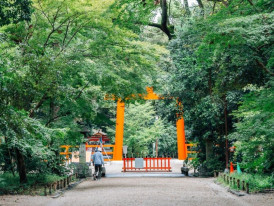
Ancient trees and cherry blossoms at Shimogamo Shrine cast shifting light patterns across the forest floor in spring.
Keage Incline: Industrial Heritage Meets Natural Beauty
The Keage Incline creates an unexpected setting where cherry trees line an abandoned railway track, creating tunnel-like passages of bloom. This unique location demonstrates how Kyoto integrates historical elements with natural beauty in surprising ways.
The incline's elevation provides views across the city while offering an intimate walking experience beneath blooming branches. This combination of industrial heritage and natural beauty creates photographs and memories that capture Kyoto's complex character.
Rivers, Gardens, and Seasonal Rhythms
Kamogawa River: Cherry Reflections
The Kamogawa River serves as a natural timeline for cherry blossom season, with trees along its banks blooming at slightly different times due to microclimatic variations. Walking riverside paths reveals how spring progresses through the landscape at nature's own pace.
Cherry petals floating on the river's surface create constantly changing natural art installations. These ephemeral displays remind viewers that beauty often lies in impermanence. It’s a central theme in Japanese aesthetic philosophy.
Garden Design and Seasonal Awareness
Kyoto's temple gardens demonstrate a sophisticated understanding of how cherry blossoms interact with other design elements throughout the blooming season. Garden designers positioned cherry trees to be viewed from specific angles. These create composed scenes that change character as flowers appear, reach full bloom, and eventually fall.
Understanding these design principles enhances appreciation for what you're seeing. Gardens become not just pretty spaces. They are sophisticated expressions of aesthetic philosophy that use cherry blossoms as one element in complex seasonal compositions.
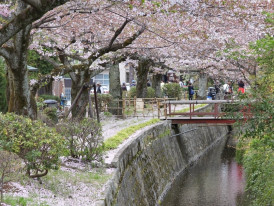
Cherry blossom petals lie across traditional stone garden paths with soft shadows in a quiet Kyoto temple setting.
Photography Tips for Capturing Kyoto in Spring
Light and Timing for Cherry Blossoms
Cherry blossoms respond dramatically to changing light conditions throughout the day. Early morning light creates soft, ethereal effects that emphasize the flowers' delicate character. Afternoon light can create more dramatic contrasts. Evening illuminations transform familiar scenes into magical landscapes.
Understanding how light affects cherry blossom photography helps capture not just images. It also reveals the emotional quality of different times and places. The play of light through petals creates constantly changing displays that reward patient observation.
Seasonal Photography Ethics
Respecting both the natural environment and the cultural significance of cherry blossom viewing requires mindful photography practices. This means staying on designated paths, not climbing trees for photos, and being aware of how your presence affects others.
The most memorable photographs often come from patient observation rather than aggressive positioning. Allowing the natural beauty to reveal itself creates more authentic images than forcing dramatic compositions.
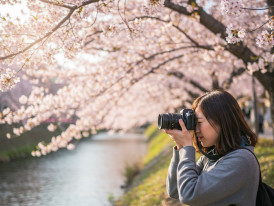
A photographer takes pictures of cherry blossoms at dawn, keeping a respectful distance from the trees in Kyoto.
Weather and Seasonal Variations
Spring weather in Kyoto can vary significantly, affecting both cherry blossom timing and viewing conditions. Rain can end bloom seasons quickly. But it also creates beautiful effects with wet petals and misty temple grounds. Sunny days extend blooming periods and create ideal conditions for hanami celebrations.
Understanding weather patterns helps plan visits that account for seasonal unpredictability. Flexible itineraries allow for adjusting plans based on actual blooming conditions rather than predetermined schedules.
Food, Culture, and Seasonal Celebrations
Spring Flavors and Cherry Blossom Foods
Kyoto's spring cuisine incorporates seasonal awareness that parallels cherry blossom appreciation. Traditional sweets feature cherry blossom flavors and colors. Restaurant menus highlight spring vegetables and preparations that celebrate the season's delicate character.
Experiencing seasonal foods while surrounded by cherry blossoms adds another sensory layer to spring visits. Local shops near temples often offer special treats during bloom season, creating opportunities to taste as well as see the season's specialties.
Cultural Context for Flower Viewing
Understanding hanami as more than just looking at flowers helps visitors appreciate the deeper cultural significance of cherry blossom season. This tradition connects people with natural rhythms and strengthens community bonds through shared appreciation of beauty.
Participating respectfully in hanami culture means recognizing that flower viewing holds both social and spiritual meaning. These gatherings show how natural beauty can deepen human connection.

Traditional Japanese sweets in cherry blossom colors arranged on bamboo plates during Kyoto’s spring season.
Seasonal Awareness in Daily Life
Spring in Kyoto shows how seasonal awareness can be part of daily life, not just something reserved for special occasions. Locals check cherry blossom reports, plan gatherings around bloom timing, and adjust their routines to make space for spring’s brief but vivid beauty.
This kind of natural observation woven into daily habits offers lessons in how to appreciate seasonal change more deeply, wherever you live. Cherry blossom season in Kyoto becomes a quiet masterclass in paying attention.
Planning Your Kyoto Trip in Spring
Accommodation and Location Strategy
Staying in locations that provide easy access to multiple cherry blossom viewing areas maximizes opportunities for early morning and evening visits when crowds are lighter. Areas near Kawaramachi Station or Demachi Yanagi Station offer access to various districts without requiring long commutes.
Consider how your accommodation choice affects your ability to experience different aspects of spring in the city, especially during cherry blossom season, when popular destinations may become crowded.
Seasonal Packing for Kyoto Spring
Spring weather in Kyoto requires layered clothing that can adjust to significant temperature variations throughout the day. Morning visits to temple gardens may be cool. Afternoon sun often brings warm conditions. Evening hanami gatherings usually call for additional layers.
Comfortable walking shoes become essential for navigating temple grounds and hillside locations where the most beautiful cherry blossoms often bloom. Many viewing areas require walking on uneven surfaces or climbing stairs to reach optimal vantage points.
Creating Peaceful Experiences
Finding peaceful experiences during the popular cherry blossom season requires strategic timing. It also takes a willingness to explore beyond the most famous destinations. Early morning visits, alternative routes, and lesser-known locations offer opportunities for personal connection with spring's beauty.
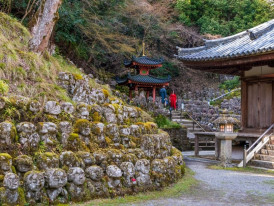
A peaceful morning at a lesser-known Kyoto temple with cherry blossoms and no crowds in sight.
This kind of approach leads to more meaningful experiences. It shifts the focus away from checking off famous spots and toward a genuine appreciation of seasonal beauty.
More than 26,287 5-star reviews and counting
26,287+ 5-Star Reviews and Counting
Trusted and recommended by travelers worldwide.
Seasonal Transitions and Extended Spring
From Plum Blossoms to Cherry Season
Spring in Kyoto actually begins with plum blossoms in February and early March. This creates opportunities for extended seasonal experiences. Understanding this broader timeline helps you appreciate how different flowers contribute to the city's spring awakening.
Plum blossoms offer a more subtle beauty than cherry blossoms. But their earlier timing allows for quieter temple visits before the larger crowds arrive. Many temples feature both plum and cherry trees, creating layered blooming seasons.
Late Spring Discoveries
After peak cherry blossom season ends, late April and early May bring other flowering trees and garden displays that extend spring beauty. Azaleas, wisteria, and various mountain flowers create continued opportunities for seasonal observation and photography.
These later spring flowers often bloom in locations that were crowded during cherry blossom peak. This provides chances to revisit favorite temples and gardens in a different seasonal context. Extended spring awareness reveals Kyoto's complex relationship with natural beauty.
Connecting with Natural Rhythms
Spring in Kyoto offers lessons in developing awareness of natural rhythms that extend far beyond cherry blossom viewing. The city's approach to seasonal celebration shows how human culture can enhance appreciation of natural beauty without overwhelming it.
This blend of cultural and natural awareness creates space for deeper travel experiences. It connects visitors with both place and season. Cherry blossom season becomes a gateway to understanding broader relationships between human culture and natural cycles.
One Gentle Petal at a Time
Spring in Kyoto teaches patience, appreciation, and awareness of beauty's impermanent nature. The brief intensity of cherry blossom season concentrates a year's worth of anticipation into a few precious weeks, creating experiences that linger in memory long after petals have fallen.
The city's way of celebrating spring offers models for developing seasonal awareness wherever you live. Cherry blossom appreciation is deeply woven into daily life, cultural practice, and spiritual observation. That understanding offers insights that go far beyond tourism.
Whether you're walking the Philosopher's Path in early morning light, sharing hanami celebrations with Japanese families in Maruyama Park, or discovering hidden temple gardens where cherry trees bloom in solitude, spring in Kyoto connects you with both natural beauty and cultural wisdom.
The flowers themselves become teachers. Through their brief perfection, they show that impermanence and beauty are not opposites but partners in creating moments worth treasuring. This understanding transforms simple flower viewing into something deeper. It becomes a practice of awareness that enriches not just travel, but daily life itself.
When cherry blossoms bloom in Kyoto, they invite us to slow down, pay attention, and remember that the most profound beauty often appears quietly, lasts briefly, and rewards those who approach with patience and respect. In this ancient imperial capital, spring continues its annual teaching, one gentle petal at a time.
To explore things to do in Kyoto in summer and beyond, let the city's changing seasons guide your journey through Japan's ancient heart.
Make Kyoto your own
SEE KYOTO EXPERIENCESSpring in Kyoto, One Petal at a Time
Discover Kyoto’s cherry blossom season with a local by your side, from famous spots to peaceful hidden corners.
Chat with a Kyoto local before you go
Ask anything about your spring trip. It’s free, friendly, and totally tailored to you.
